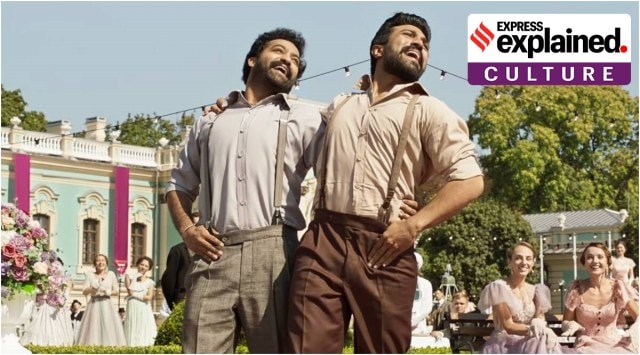Latest Comment
Post Comment
Read Comments
 In the dance sequence, Jr NTR (left) and Ram Charan use their suspenders in creative ways to mesmerise the audience. (Photo: Still from RRR)
In the dance sequence, Jr NTR (left) and Ram Charan use their suspenders in creative ways to mesmerise the audience. (Photo: Still from RRR) On January 10, Naatu Naatu, the spellbinding dance number from SS Rajamouli’s epic RRR, won the Best Original Song in the 80th Golden Globe Awards. The song, composed by MM Keeravani, features the film’s two protagonists, Jr NTR and Ram Charan, grooving to the upbeat track, pulling off some incredible moves in the process. Notably, the two actors use their suspenders as a prop while dancing – playing around with the accessory in creative ways.
Suspenders were a crucial part of menswear back in the day, before waist-belts caught up. Also known as braces or galluses, they kept pants up and were hidden under the coats or jackets worn by men at the time. Theoretically, two men dancing around with their suspenders would actually be deemed offensive in England in the 1920s, when RRR’s story takes place.
The history of suspenders is intertwined with the history of belts as well as the history of pants. Suspenders fought (and lost) a long battle with belts as the premier tool to keep pants in place. However, for a long while, they were not only the most commonly used accessory, they were necessary due to how pants were tailored.
The Indian Express takes a brief look at the rise and fall of suspenders as a necessary piece of menswear.
After centuries of wearing tights or breaches, trousers started to become popular by the early 1800s. The popular cut was high-waisted. This rendered belts, which were popular before, to become uncomfortable and often useless as they would simply slide down when the person breathed out. A different kind of accessory was the need of the hour, that could help keep pants in place while not squeezing the stomach of its wearer.
In came suspenders. While early versions emerged in France during the 1700s, they became popular alongside the rising popularity of high-waisted trousers, a century later. British tailor Albert Thurston is credited with the invention of the modern suspenders, or “braces” as they are called by the British.
Thurston’s model used tightly woven wool and leather loops to be attached to buttons sewn inside the pants. Furthermore, unlike modern suspenders which have a “X” or a “Y shape” in the back, early models were “H shaped,” with two parallel straps kept together with a piece of cloth between them. Crucially, suspenders were seen as “undergarments” and all effort was made to keep them hidden from sight. Waistcoats played a crucial role in this regard.
An individual’s whims can often cause enduring changes in fashion, regardless of his intentions. Case in point Samuel Clemens, better known by his pen name, Mark Twain. The story goes that Clemens disliked existing suspenders so much that he invented an alternative and filed for its patent.
Calling it an “Improvement in Adjustable and Detachable Straps for Garments,” the point of the invention was to do away with restrictive suspenders which went over the shoulders, using an adjustable strap instead. Notably, at the time, existing belts were largely decorative.
 An image of Mark Twain’s invention, as on the original patent application.
An image of Mark Twain’s invention, as on the original patent application.
While this did not revolutionise suspenders as Mark Twain would have hoped, his invention still has an enduring legacy. In the longer term, writes Rebecca Greenfield for The Atlantic, “this clever invention only caught on for one snug garment: the bra. For those with little brassiere experience, not a button, nor a snap, but a clasp is all that secures that elastic band.” Mark Twain’s design is still the rough basis for modern bra clasps.
Throughout the 19th century, suspenders remained the preferred choice for men, undergoing small, functional changes such as the introduction of elastic and modifications to the buckling system. An exception was 1893, when a heatwave pushed many to shift to belts – so they could take their coats without being “indecent.”
However, World War I brought major changes to fashion, affecting the popularity of suspenders. As millions of men got used to military uniform, low-waisted and tight-fitting, fashion in the post-War era catered to these new trends. Crucially, lower waists made suspenders less comfortable to wear, with leather belts flooding into the market.
Furthermore, as waistcoats became less popular over time, suspenders also suffered, as men stopped wearing the garments that traditionally concealed them. This was especially true in America. In 1938, Life magazine stated that 60 per cent of American men chose belts over suspenders.
In the UK, on the other hand, suspenders remained a norm to be worn with suits and dress trousers.
While post World War I, suspenders never really reached the kind of universal usage they had pre-War, over the years, they have made various comebacks.
In the 1940s, when fuller-cut trousers made a return, suspenders were revived along with them. Even today, suspenders are worn by various professionals, with films like Wall Street (1987) and figures like Larry King, contributing to their enduring appeal. Even punk fashion and the skinhead movement adopted particular kinds of suspenders.
I love my new holdup suspenders check ’em out! pic.twitter.com/WpLi6Tp0j0
— Larry King (@kingsthings) October 13, 2013
One possible reason for suspenders’ enduring use could be their role in improving posture and comfort, especially for men with rotund bodies. “It is recommended that those who carry weight on their belts also wear suspenders for increased comfort,” Dr Ken Hansraj, spinal and orthopaedic surgeon in New York state, told He Spoke Style.



